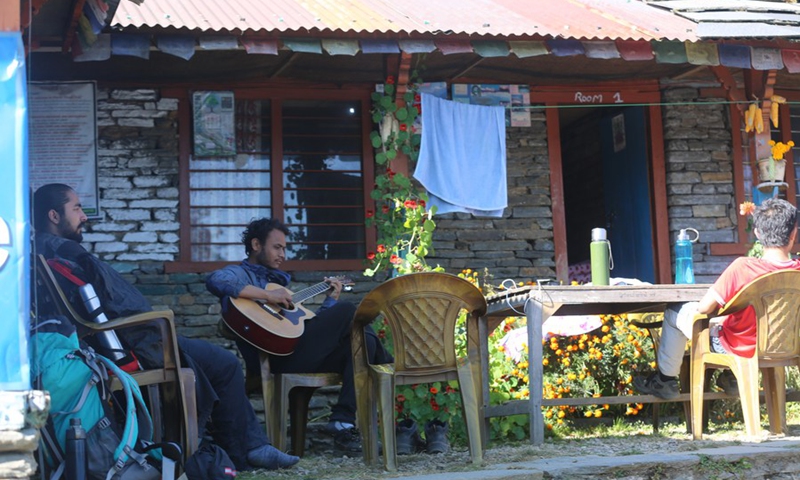Nepal in full readiness to welcome back Chinese tourists to help drive post-COVID economy: insiders

Tourists are seen in the Annapurna Region, Nepal on Nov. 9, 2020. (Photo: Xinhua)
Nepal, a neighboring country with increasingly strong connectivity with China in areas ranging from economic issues to trade and investment, is excited to welcome Chinese tourists back.
Tourism will inject momentum into the economic recovery of the mountainous country in the post-COVID era, industry observers said.
Cities in China have gradually resumed direct flights to Kathmandu, capital of Nepal along with other optimized measures, and industry observers expect the number of tourists from China could recover to the pre-epidemic level this year.
"Nepal was seeing a steady rise of Chinese tourists before COVID but the pandemic led China to 'shutdown' from 2020 to 2022, which affected Nepal's tourism along with the whole world's, and is considered the worst period for the global economy," Dhananjay Regmi, CEO of the Nepal Tourism Board, told the Global Times in an exclusive interview.
"Now that China has opened its borders to all, we are very glad to welcome our friendly neighbors once again," Regmi said.
Nepal has been a popular destination for many Chinese travelers for its unique qualities and premium experiences, a trend that showed resilience even during the pandemic, Regmi said.
In 2019, nearly 1.2 million tourists visited Nepal, around 14 percent of whom were Chinese, industry data showed.
"Despite the travel restrictions, we still received 9,595 Chinese travelers in 2022, compared with 169,543 in 2019," Regmi said.
Chinese tourists usually enjoy Pokhara, the lake city, more than Kathmandu as it has quite a number of adventure activities like boating, mountain flights, ultra-light flights, paragliding, zip line rides and treks, to name a few, Regmi said, hoping for a rebound in Chinese visitors in 2023.
All foreign tourists including those from China are currently required to produce official proof of a COVID-19 vaccination with a QR code or PCR negative report taken 72 hours prior to boarding, according to the epidemic control protocol of Nepal.
This entry protocol is for all visitors and not only for Chinese visitors, according to Regmi.
While Chinese visitors to Nepal are still few compared with the years before COVID, the numbers might increase if more cities allow international flights to Nepali cities like Kathmandu, Pokhara, and Bhairahawa, Kalyan Raj Sharma, an industry analyst in tourism, who is also the president of Nepal AOE Travel Company based in Kathmandu, told the Global Times.
Some cities in China and international airlines have started operating direct flights to Kathmandu again.
For example, Himalaya Airlines plans to resume a weekly direct flight between Beijing and Kathmandu starting from January 17 while flights to cities such as Chongqing, Shenzhen, Guiyang and Changsha are expected to resume later.
China Southern Airlines resumed its direct flights between the Chinese southern city of Guangzhou and the Nepali capital in late November.
Industry observers have high expectations for a rise in outbound tourists from China, which is Nepal's largest source of international travelers. In Nepal, every six visitors create one job, and the tourism sector improves living standards of local citizens.
As Nepal looks to recover from economic stagnation incurred during the pandemic, China's support to Nepal as a tourist destination must be welcomed as a boost to Nepal's economy, Regmi said.
"Chinese imports can be paid for with more Chinese currency if there are more Chinese tourists. Increased tourism is one way to attract Chinese yuan reserves given Nepal's scant exports to China," Sharma said.
In an interview with the Global Times, the Nepali Ambassador to China Bishnu Pukar Shrestha said that "with the lifting of border restrictions, travelers will increase in number. China and Nepal will resume economic cooperation." He expects more Chinese businessmen to visit Nepal and more investment in the prioritized sectors of Nepal.
With the reopening of the border and the lifting of restrictions amid China's further optimized epidemic controls, countries such as Thailand, Indonesia and Malaysia are all welcoming the return of Chinese tourists, a group that has the most consumption power.
Speaking at a regular press conference on Wednesday, Chinese Foreign Ministry spokesperson Wang Wenbin said that China will continue to optimize and adjust relevant measures in response to the epidemic situation, while working with all parties to ensure the safe, smooth and orderly travel of Chinese and foreign personnel, contributing to international solidarity in fighting against the pandemic and the recovery of the world economy.

